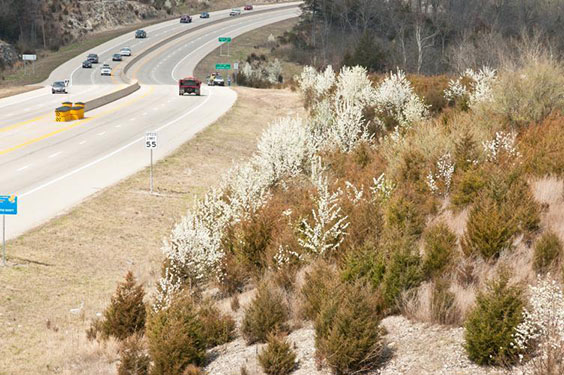JEFFERSON CITY, Mo. – Spring has sprung, and many Missouri plants and trees have already begun to bloom. Unfortunately, one invasive tree will be prominent along roadways and other open areas: the Callery pear tree.

Callery pears are easily spotted in spring in open natural areas and along roadsides, such as this one Jefferson City. This invasive tree spreads quickly and crowds out native plants and trees. MDC encourages the public to go native when looking for a new tree to plant this season.
In an effort to eradicate these invasive, nonnative trees from the landscape, the Missouri Department of Conservation is partnering with the Missouri Invasive Plant Council, Forest ReLeaf of Missouri, and Forrest Keeling Nursery to host a Callery pear “buyback” program April 23.
Missourians with Callery pear trees on their property have the opportunity to cut down their tree and receive a free, native tree in return.
Registration to receive a free tree is open March 15 – April 15.
Participants must register online and submit a photo of their cut down Callery pear. One free native tree will be provided to each registered participant at the selected location on the day of the event, April 23 from 3 p.m. – 6 p.m. Participating cities include:
- Louis
- Columbia
- Cape Girardeau
- Farmington
- Kennett
- Springfield
- Joplin
- Lebanon
- Hannibal
- Rolla
- West Plains
- Kirksville
- Joseph
- Kansas City
For more information on the buyback events and how to register, visit moinvasives.org.
WHY ARE CALLERY PEARS SO BAD?
The Callery pear, also known as the Bradford pear, Cleveland Select, Autumn Blaze, or Aristocrat, is a highly invasive tree that multiplies quickly and crowds out native plants.
The tree rose to fame in the 1960s as a popular ornamental landscape tree.
“This tree species became popular because it was inexpensive, it grew quickly, and provided showy white blooms in the spring,” said MDC Forestry Field Programs Supervisor Russell Hinnah. “But the bad outweighs the good. Different varieties of the tree were planted close to each other, resulting in cross-pollination and spreading the tree nearly everywhere.”
Callery pears’ ability to cross-pollinate is why many roadsides, rights-of-way, parks, and other natural areas are filled with more white blooms every spring. They quickly invade open areas and crowd out native tree species.
The trees are infamous for their stinky smell, but they also have a poor branch structure, often losing limbs or splitting apart in severe weather.
MDC encourages homeowners and landscapers to go native when picking a tree to plant this season.
“The best decision is to plant a tree species native to Missouri, and there are many great substitutions,” said Hinnah. “Serviceberry trees grow similar white blooms in the spring, and they have small red fruits that attract wildlife.”
Other alternatives include hawthorn, eastern redbud, and Missouri’s state tree, the flowering dogwood. Hawthorns provide bountiful fruit and attractive fall color, while dogwoods thrive in shady areas, but can be difficult to grow.
Learn more about native trees and landscaping online at https://mdc.mo.gov/trees-plants/tree-care.
